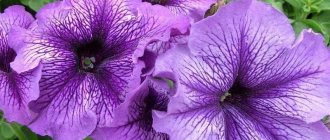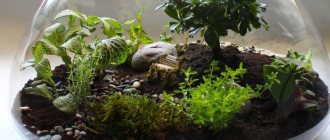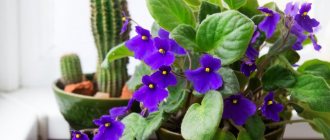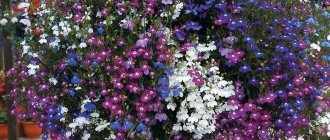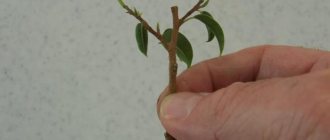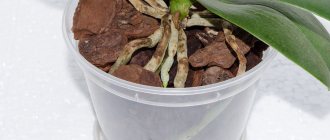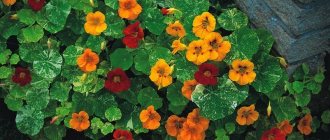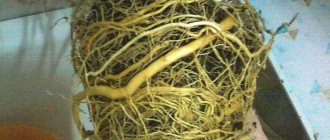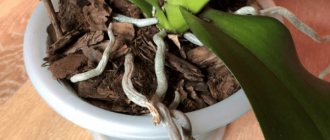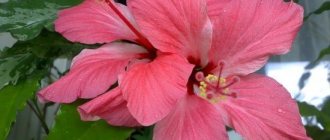How to plant lobelia?
Transplanting lobelia into pots becomes necessary if the sprouts are intertwined with leaves, roots and stems. This occurs at the stage of 2 – 3 true leaves. Even if the main plant is small, this is the optimal time for replanting. Do not forget that it is mandatory to prepare pots for replanting plants in them. You should not use glazed or porcelain dishes, because they will not allow fresh air to reach the lobelia roots. Clay is also not particularly suitable due to frequent stagnation of water. The pots should be washed with hot water and scalded with boiling water.
When to transplant lobelia into pots?
Lobelia is planted in a pot an average of a month after germination. Expanded clay should be present at the bottom of the pot, since the flower cannot tolerate stagnant moisture. You can plant them first in 100 gram cups, and then in pots or cache-pots. If planting plants in open ground was not planned, then the seeds can be immediately sown in a flowerpot or pot, and excess shoots removed. In this case, you won’t have to think about how to properly plant lobelia in pots.
After the picking process, it is necessary to have lighting and an air temperature above +15 degrees. Moderate watering is required around the bushes. After three weeks, the first feeding with a special vitamin complex should be organized. But you shouldn’t get carried away with fertilizing either; this does not always benefit the plants; often, overfeeding with fertilizers affects the flowers in the most negative way.
How to plant lobelia in pots correctly?
Planting lobelia in a pot is not as difficult as some people think. Plants are planted in several bushes, while trying not to damage the root system of each flower. The algorithm is as follows:
The soil must be added so that at least 2 cm remains from the soil to the top edge of the pot. This will make it more convenient to water the plants. Excessive zeal in watering is not necessary, as it can provoke the development of various diseases. Once a week is enough for normal development and flowering.
What size pot does lobelia like?
The volume of the lobelia pot should not be huge, otherwise the plants will simply stretch out and lose their attractive appearance. However, its diameter will depend on the type of plant. If the variety is bushy, then a pot of 600 - 800 ml is enough for one bunch. If you plan to plant lobelia with a companion, then the bunches growing in one glass do not need to be divided, although this is often written on packets of seeds.
How many lobelia plants to plant in one pot depends on the diameter of the pot itself. You can plant from 10 to 12 pieces in a pot with a diameter of 25 cm. Some housewives prefer to plant more: up to 20 plants in one pot. If there are not enough seedlings, then you can plant three of them, press the stems to the ground, after a month the bushes look like a lush head. Lobelia seedlings require less space than, for example, ampelous petunia.
Lobelia in pots interesting ideas
Lobelia in pots outside looks great together with other plants:
Several lobelia bushes in one pot look interesting, and the varieties should be different, but combined in size and color. Companion plants for lobelia should have similar care requirements. In addition, it is better to use short varieties to avoid the harmful effects of wind and rain on neighboring flowers. To make plants look impressive, you need to promptly remove faded buds and pinch shoots that have grown too long. Such simple care will allow you to admire the flowering for a long time.
The flower harmonizes perfectly with bamboo-like plants, forms a single picture with them and pleases the eyes of the owner and guests. If you want to decorate plants in a water theme, then you need to choose shades of blue or light blue. The blue color scheme in this case will become a highlight and fit perfectly into the landscape.
Source
Useful tips for growing lobelia seedlings
One of the important points when caring for seedlings is timely watering.
Since lobelia seedlings are very small at the initial stages, watering should be done correctly using a syringe with a needle.
After the first true leaves appear, the plant can be planted in pots in families of several seedlings, choosing the most:
- strong;
- juicy;
- quality.
It is correct to pinch bush varieties of flowers after a certain period of growth, then the flower will branch well, but ampelous varieties do not need pinching.
The correct conditions for seedlings to grow after they hatch are a temperature of 13-17 oC and good natural light.
Important!!!
Despite the fact that lobelia is thermophilic, hardened seedlings tolerate light frosts down to –1 °C.
What problems can you encounter when growing?
The main problem when growing seedlings is watering.
Important!!!
If the plant is flooded, the thin seedlings will become moldy, and if there is little moisture, the seedlings will instantly curl into a tube.
Light also influences growth; there should be a lot of it. If this moment is ignored, the seedlings will stretch upward.
It is for this reason that experienced gardeners recommend using additional lighting when the seedlings are on a northern windowsill.
It is also important to consider the timing of fertilization. Resist the temptation to feed the seedlings; feeding will be harmful during initial growth.
Resist the temptation to feed the seedlings; feeding will be harmful during initial growth.
You should fertilize:
- already in the flowerbed;
- in containers on the loggia;
- in flowerpots or flowerpots.
It is important to comply with the conditions, then the seedlings will be strong and the color will be active. Lobelia
Lobelia
Flower varieties
Lobelia comes in several types.
Dwarf
The plant branches heavily, reaches a height of 20 cm. The flowers are small, about 2 cm. The colors are blue, white, purple, pink. This variety, in turn, is divided into two subspecies:
The only important thing for him is that the soil is always moist.
Compact
This variety is in great demand because it can be grown not only in the garden, but also at home, on the balcony. Another compact lobelia is often used to decorate flower beds. It grows no more than 15 cm in height.
It is characterized by abundant and long flowering, which is also a huge plus. The color of the flowers is predominantly blue.
Erect
This variety is distinguished by a straight stem and a height of up to 75 cm. Lobelia of this variety prefers high humidity. For this reason, in wild places, she likes to be located next to bodies of water and wetlands.
Ampelnaya
This type of plant is characterized by the presence of long shoots. It is recommended to use flowers for flower pots and home flower beds. By color there are white, blue with a white eye or heavenly with a white eye.
The variety is quite resistant to temperature changes.
Picking
When two true leaves form on the plants, pick the seedlings into separate cups. This must be done very carefully in order to preserve as many roots as possible. Do not separate bunches that have grown together too tightly; replant them entirely.
The first time after picking, protect the seedlings from direct sunlight, and when they get a little stronger, move the pots to a bright room with a temperature of about 20 °C. You can take it out onto the balcony or loggia.
By the way, look at the previous article. There is a lot of useful information for you - Kobeya: growing from seeds.
When the seedlings reach a height of 3.5–5 cm, pinch off the tops to obtain lush, compact bushes.
If this is not done, the bushes will grow looser and longer-braided.
Advantages of growing from seedlings
Flower growers do not always want to grow lobelia in their gardens because they are afraid of getting into a lot of trouble. After all, the plant has very small seeds, so planting it immediately in a permanent place really turns out to be difficult.
But lobelia seedlings will help avoid problems.
Also, the advantage of growing through seedlings is that as the flowers develop, you can take measures to strengthen their immune system and protect them from pests and diseases.
As a result, crops planted in a permanent place will be many times more stable than those sown directly in open ground.
Growing seedlings
Growing lobelia as seedlings will allow gardeners to admire the buds from the first months of summer, if everything is done correctly and carefully. In order to start planting seedlings, you need to prepare in advance the container necessary for planting them. And you need to start the sowing stage from the first days of February. First of all, you need to prepare the soil for this amazing flower. You will need garden soil, which must be mixed with ordinary river sand.
Popular articles Control measures for thrips on gladioli
Note! And to kill various bacteria, you need to keep it in a regular oven for 10 minutes at 180 degrees. You need to make a small hole in the container where the seedlings will be sown.
It is necessary for the outflow of fluid. Next you need to pour a fairly thick layer of expanded clay or broken brick. Pre-roasted soil is poured into the container and pressed a little, leveling it in advance. When soil is poured into the container, it needs to be rinsed. After moistening the soil, seeds are placed in it, only they need to be distributed at large intervals from each other. It will be more convenient to do this with seeds that are in granules. All containers must be covered with glass or a bag. Then the containers with future seedlings are placed in a place where it is warm and has enough light
You need to make a small hole in the container where the seedlings will be sown. It is necessary for the outflow of fluid. Next you need to pour a fairly thick layer of expanded clay or broken brick. Pre-roasted soil is poured into the container and pressed a little, leveling it in advance. When soil is poured into the container, it needs to be rinsed. After moistening the soil, seeds are placed in it, only they need to be distributed at large intervals from each other. It will be more convenient to do this with seeds that are in granules. All containers must be covered with glass or a bag. Then the containers with future seedlings are placed in a place where it is warm and has enough light.
Sowing seeds in a pot
Firstly, you need to understand that the soil for lobelia needs airy, light, moist and loose. The soil must be well saturated with air for the plant to be comfortable. Seedlings need to be planted in open ground, which contains sand and humus. The plant successfully takes root in slightly acidic or neutral soil. A small pot or any similar container is suitable for sowing seeds. Sometimes seeds are placed directly into open ground.
Flower in a hanging pot
Preparation for the sowing procedure
For further sowing, you will need to prepare the soil and container.
What primer should I use?
For lobelia, you need to prepare the soil. The flower loves soil with the following characteristics:
You can prepare the soil yourself from soil, humus, river sand and peat in a ratio of 2:2:1:1.
If the soil is highly acidic, it is necessary to add a small amount of wood ash or dolomite flour to it before planting. These components are capable of neutralizing acid.
Before sowing, it is important to disinfect the soil using high temperature. To do this, place in the oven for half an hour, maintaining 90 degrees. Then hold it over steam for 60 minutes.
Selection of capacity
You can sow lobelia in any container; there are no strict requirements for choice. The main thing is that it is spacious and not too deep. Flower growers purchase special containers in stores or adapt something at hand.
The following options are possible:
It is important that the bottom of the container has holes for drainage. They are not required only when using peat cups and tablets.
Seed sowing process
Sowing lobelia seedlings does not require any special knowledge or skills; any novice gardener can do it. The only difficulty is that the seeds are small; they must be handled very carefully so as not to spill.
Step-by-step landing algorithm:
You can sow lobelia in rows, having previously made grooves with a distance of 2-3 cm from each other. This option is even better, as it will simplify the task of caring for plants in the future.
Seedling care
As soon as the sprouts appear, you need to move the containers to a bright place and follow the rules of care:
During the process of growing lobelia, you need to regularly check whether it has been exposed to any diseases or harmful insects.
Timely detection will help you quickly cope with troubles and save flowers.
Picking and pinching
You can pick lobelia when 2-3 full leaves appear. You should not perform the procedure earlier or, conversely, be late.
The process requires special care from the grower; it takes a lot of time and effort. The sprouts are very small; to extract each of them, you need to use a stick or a teaspoon. It is better to transfer the seedlings with tweezers directly along with the soil, so as not to harm the roots.
Pinching is carried out in order to form a neat and lush lobelia bush. When the sprout reaches a height of 4 cm, its top is trimmed using scissors pre-treated with a disinfectant.
How to care for lobelia seedlings after planting
You have to wait from 5 to 10 days for the first friendly shoots of lobelia, although it usually takes less than a week if you did everything correctly when sowing.
Experienced gardeners advise that in the first days after the emergence of lobelia shoots, be sure to use special lamps for additional illumination. These can be either expensive phytolamps or more economical LED ones.
The temperature at which lobelia seedlings grow well at home is +20-..+22 degrees.
As the seedlings grow, the cover (film) should be gradually removed. Starting from 10-20 minutes in the morning and evening, gradually increasing this time to several hours, and then, when the sprouts have finally gotten stronger, it can be completely removed.
Lobelia is a very moisture-loving plant, but it is worth knowing that it has very fragile roots, which, moreover, are located in the very top layers of the earth.
Video: how to grow lobelia - caring for seedlings
Watering and fertilizing
Proper watering of newly emerged lobelia sprouts is carried out with a small spoon along the edges of the container, and in no case on the plants (therefore, the use of a sprayer in the first days of the plant’s life is not recommended).
Do not let the soil dry out, otherwise the small plant will not be able to survive and will quickly die.
It is very convenient to monitor the humidity based on the condition of the sand.
As a rule, young crops of lobelia seedlings do not need fertilizing and fertilizing. However, growing seedlings should be protected from diseases with the biological product “Glyokladin”, which suppresses various infections in the soil. Application rate: 1 tablet per 300-400 ml. soil. The tablet is placed directly into the ground with seedlings in a free area.
Picking
Lobelia seedlings should be picked when they have 2-3 leaves. This must be done in bunches of 5-10 sprouts. As a tool, you can use the most ordinary teaspoon or any other device.
For better survival of picked seedlings, they can be shed with Energen. Consumption - 1 ml. product (or 15 drops) per 2 liters of water.
Video: picking lobelia seedlings
Pinching for lush flowering
When the height of the lobelia seedlings reaches 5-7 cm and it already has 5-6 true leaves, you can pinch the tops of the plants, which will have a beneficial effect on the more luxuriant formation and flowering of the bushes.
Transplanting into the garden
Before planting the plants in a permanent place, they need to be hardened off. This way they will be less stressed and adapt better to new conditions. To carry out hardening, you will need a temperature of at least 13 degrees above zero.
It is important to start the procedure at least a week before the transplant. It consists of two stages:
If the acidity is high, add wood ash or dolomite flour to the soil. In case of low fertility, sprinkle the planting site with compost and sand.
It is recommended to place seedlings in groups with a distance of 15-25 cm from each other. If there are any other flowers nearby, it is better to choose a place with low-growing crops, otherwise the lobelia simply will not be visible.
The bush should be moved along with a lump of earth. After replanting, be sure to water the plants and cover the surface of the bed with mulch.
Transplanted flowers require further care. It is important to regularly water them, loosen the soil, remove weeds and fertilize them. Also, don’t forget to check for diseases and pests.
Thus, lobelia is a beautiful and profusely flowering plant that can decorate a garden, windowsill, or balcony. In combination with other colors, you can create a lush and unique carpet.
You can plant directly in open ground or start by growing seedlings.
Source
Planting and caring for lobelia in the garden
Unlike tender seedlings, mature seedlings are more unpretentious. Provide them with proper care, and they will respond with lush clouds of flowers.
Choosing a planting site, soil characteristics
For growing in the garden, select moderately lit areas. The southerner will grow in the shade, but the flowering will not be so lush. Due to excessive solar radiation, the soil surface quickly dries out, and the inflorescences fade and change color.
As for the soil, you should pay attention to its fertility. The African guest will happily settle in an area rich in organic matter, only all the growth will go into leaves
In its homeland, it grows in poor soils and blooms beautifully. Sandy loam and loam are suitable for it. They are quite loose and provide good drainage and ventilation of the roots. In the fall, fertilize the soil with sand and vermiculite.
When to sow seeds in open ground, seed sowing technology
In warmer regions, sowing directly into open ground is possible. In the south of Russia this can be done as early as mid-April. Granular material is very convenient. Plant at a distance of 15 cm from each other. The southerner will bloom towards the end of July.
In the Middle Zone it is not recommended to carry out such work in open ground. If you don't want to bother with seedlings, you can use a greenhouse. Plant the seedlings in pots and grow them in greenhouse conditions. This should be done as soon as the snow melts, i.e. already in April.
Caring for a plant in open ground
After rooting the seedlings in a permanent place, re-pinch. The guest from the Cape Kingdom has a gentle disposition and will not require your care. All you need to do is remove weeds in a timely manner and monitor watering. It should be done twice a day, especially in hot weather. Once the soil dries out, you are unlikely to revive the moisture-loving flower. Fertilizing is carried out after the end of primary flowering. For these purposes, use potassium-phosphorus complexes. They are aimed at stimulating the development of peduncles.
One of the most important aspects of care is pruning. After the first wave of flowering, the branches are pruned, leaving shoots 5-6 cm long. This stimulates new tillering and the reappearance of flower stalks.
Growing lobelia from seeds
Lobelia is a simple and understandable plant that is suitable for a novice gardener to get acquainted with growing cultivated plantings in a flower bed. Lobelia is diverse and multifaceted, it is planted as a perennial and annual plant (in the middle zone of our country, most often, lobelia is still an annual crop), there are at least three hundred varieties of lobelia, including ampelous and bush crops, plants with blue, red and white flowers. Today’s story is about how to grow lobelia on a plot.
Dates for sowing lobelia seedlings in 2022
When is the best time to sow lobelia seeds for seedlings? You can sow in the second half of February and in March . But some gardeners choose earlier planting dates - in January (however, such an early procedure will require more meticulous care and additional lighting).
It is also recommended to take into account the weather and climatic characteristics of the regions in which it is planned to grow flower crops:
- In the middle zone (Moscow region) it is better to plant in early March;
- In the South, this can be done in early or mid-February;
- In Siberia, the Urals, and the Volga region - in the middle and end of March.
Many summer residents rely on lunar cycles when choosing the right time. Thus, we can highlight the optimal timing for planting lobelia according to the 2022 Lunar calendar:
- Favorable days: in January: 1, 10, 11, 15, 16, 19, 20;
- in February: 7, 8, 12, 13, 14, 15;
- in March: 10, 11, 15, 20, 21, 24, 25.
- Unfavorable days: in January: 2, 18th;
- in February: 1, 16;
- in March: 2, 16, 17, 18, 31.
Planting lobelia
There are several ways to plant lobelia, choose the one you like best or which is easiest to do in your climatic conditions.
Planting lobelia seeds
The traditional way is to plant lobelia seeds in soil located in a selected small container (plastic, foam, wood - any type of container in which drainage holes can be made). I bring to your attention step-by-step instructions for planting lobelia.
Sowing lobelia in the snow
The method of sowing lobelia seeds sounds very exotic, however, contrary to the name, it can only be done in those regions where there is snow outside in winter. This same feature is the only drawback of the method, because the southern regions often do not see snow during the winter. The difference with the traditional planting method described above is small: it is necessary to pour a layer of snow on top of the prepared soil, and pour planting material onto it. Why such difficulties, you might think. However, this method has a number of advantages, and therefore is most often used by gardeners from the central and northern zone of the country.
Planting lobelia in peat pots
Another common way of planting crops for seedlings is to use peat pots. In addition to pots, you can use peat tablets.
The use of peat tablets and pots has a number of significant advantages:
What is this flower
Lobelia is one of the most popular types of flowers for the garden or cottage.
Lobelia is one of the popular plants among gardeners. It attracts attention with its delicate flowers, which grow in dense groups, and the ampelous forms hang beautifully from the flower pots, reminiscent of a waterfall. This plant is a perennial shrub of the Bellflower family, which in our country is grown, in most cases, as an annual. The flower's homeland is South Africa, where the flower grows on wet and rocky cliffs, although it can be found almost all over the world in tropical and temperate climates. In total, there are about 300 species of lobelia, of which only 20 are cultivated.
The place of lobelia in landscape design
Lobelia is quite often used in landscape design. The flower looks great both on the balcony and in the form of “carpets” near ponds, in alpine slide compositions next to other perennials. In modern design, lobelia is widely used to create coziness in the corners of the garden, for which it is planted in flowerpots or containers. The most common places for planting plants at home are flower beds, borders, and hanging baskets.
In the flowerbed
Before planting a flower on a garden bed or flowerbed, you need to think about what the color scheme of the future composition will be.
Rabatka is a rectangular flower garden in the form of a narrow strip of about 2 m, located along a fence or garden path with other plants.
To combine with lobelia, the flowerbed must be formed from similar shades: blue, lilac, light blue, violet. This combination of colors looks quite attractive: crimson and white, blue and red, yellow and blue.
To combine with lobelia, the flowerbed should be formed from purple, lilac, blue and light blue shades
In hanging baskets
When growing ampelous species, such flowers look most beautiful in hanging baskets in the form of a ball - the plants are a continuous carpet of flowers that hides the frame. One of the easiest options for planting lobelia is coconut liners. Holes are first made in them, filled with soil and plants are planted on the outside of the container.
Ampelous lobelias look great in hanging baskets
In decorative flowerpots
Lobelia looks very attractive in decorative flowerpots, for which you need to choose the right “neighbors”. If you use low-growing flowers in tandem with it, then to diversify the composition you can plant plants with different leaf textures and flower sizes. Large diameter pots are perfect for such plantings. To add dynamism to the flower arrangement, you can combine compact plants with upright growing ones.
An original solution in landscape design would be to use a flowerpot similar to a round vase. In this case, the ampelous lobelia can be planted in the bowl itself, and small bushes of this flower can be planted at the foot, making a light backfill. To add some flair to your garden design, you can install several flowerpots of different sizes with contrasting colors.
To make lobelia in flowerpots look attractive, you need to choose the right “neighbors”
Tower of flowerpots
Lobelia stands out noticeably when grown in a flower tower, that is, pots stacked on top of each other. To form such a composition, take several clay pots with a difference in diameter of about 7 cm. After this, fill the lower container with soil and insert reinforcement, which is buried in the garden soil through a hole in the bottom, thereby ensuring the stability of the flower shelf. The remaining pots are placed on top of each other, putting them on the reinforcement and filling them with soil, followed by compaction. Lobelia is planted in combination with other flowers, starting from the lower pots, after which it is watered abundantly. In such compositions, blue flowers go well with purple and pink petunia, as well as white and red balsam.
As an example, a tower of pots is given, in which the lobelia will stand out noticeably
What colors can you combine lobelia with in a flowerpot and in a flowerbed?
Since lobelia with its shoots forms small clumps that resemble pillows decorated with blue and blue flowers, the following plants will be a wonderful company:
- Alyssum, verbena, bluebell, cloves, salvia.
- To create compositions in hanging flower pots, ampelous petunia and elegant white or purple lobelia are often used.
- It is also a good idea to plant begonias, pelargoniums and impatiens next to the lobelia, with red or pink flowers.
Low-growing varieties of lemon or yellow marigolds look great next to lobelia.
Types of lobelia with creeping stems can be used as a ground cover, and if the shoots are long and drooping, the flower can be planted in a pot as an hanging plant. In this case, it is better to plant chlorophytum or asparagus nearby.
Lobelia varieties
There are a large number of varieties of lobelia, which differ in the length of the shoots, size and color of the flowers. The most popular of them are hanging and bush ones.
Ampelnaya
Ampelous lobelias (climbing) are plants with thin and long shoots up to 60–70 cm. The flowers and leaves on them are scattered along the entire length of the branch. This species looks great not only in hanging containers, but also on the ground. Long branches spread out to the sides without interfering with other flowers. The ampelous look is great for decorating large flowerpots and flower beds, but for paths this option will not be the best, since you will simply walk over the flowers.
Ampelous lobelias have many varieties, here are some of them:
Ampelous lobelia has many types and is suitable for decorating large flowerpots, flower beds, paths
Bush
Bush lobelia has spreading and compact bushes with a stem length of up to 30 cm. This species is excellent for decorating ridges, flower beds, paths, flower beds, and borders.
It is recommended to pinch ampelous lobelia, which promotes better branching.
Of the bush lobelias, the most popular variety is the Royal Palace variety. It is characterized by bright red flowers and bronze leaves. Bushes are formed in height up to 12–15 cm.
Cascade
Cascading lobelias are the most lush. Compared to ordinary ones, they are less dense, but longer - 35–40 cm. They can be planted on the ground, but a greater effect can be achieved when placed on a hill, for example, in flowerpots, pots, boxes.
Cascade lobelia has less dense bushes than regular lobelia, but longer branches - 35–40 cm
Annuals
Lobelias are also divided into annual and perennial species. Annual plants include those plants that, after flowering, are not replanted and are not transferred to more comfortable conditions for the winter. Of the annuals, species such as Ezhevidnaya, Thinest and Strong are distinguished.
Hedgehog lobelia is a bush 10–30 cm high. It is also called Erinus, blue or border. The plants have small leaves and flowers with a diameter of 1.5–2 cm. Depending on the variety, the flower may have a purple, white, light blue or dark blue color.
Lobelia Erinus has small leaves and flowers with a diameter of 1.5–2 cm, the color of which can be blue, blue, purple, white
Lobelia Strong has straight stems and lush foliage. A distinctive feature is long flowering. The shoots reach a height of 40 cm.
Perennial
Of the perennials, we can distinguish Lobelia Beautiful, Purple and Brilliant.
Lobelia the Beautiful is a plant with a shoot height of 65–90 cm. The species is quite frost-resistant and can withstand even the most severe cold.
Lobelia the Beautiful reaches a height of 65–90 cm and is a frost-resistant plant
Lobelia Purple grows well in shallow water and marshy soils, so it is excellent for decorating artificial reservoirs. The inflorescences are shaped like spikelets and reach a height of 90 cm. This species is also frost-resistant.
Lobelia Shiny - grows up to 75 cm and has small flowers of bright red color. The leaves can be red or green, depending on the variety. The plant's winter hardiness is average, so it is better to move the flower to cold, frost-free rooms in the winter.
Application in design
The lobelia flower will be a magnificent decoration for a balcony, loggia, or veranda. It is not difficult to understand how to plant plants so that they look as decorative as possible. Usually they are selected according to shades, and several bushes are placed in one pot. White lobelia looks very beautiful, complemented by flowers in pink, blue or light lilac tones. This composition can be placed against a background of dark wood or red brick walls.
Lobelia ampelous Sapphire goes well with two-color options. The bluish-white Emperor Willie will be a good neighbor. The number of flowers depends on the size of the pots. A spacious basket will accommodate several pieces at once; 2-3 stems are planted in a medium-sized pot.
A multi-tiered structure in which both ampelous and bush forms of lobelias are planted will help to decorate the balcony. A smooth transition of shades will create a spectacular composition that can be moved to any convenient place.
Blue lobelia looks impressive against a background of greenery. It can be planted near a low support or hung on a tree branch in a wicker basket. A plant with white flowers will help complement varieties with sky-blue buds. You should not combine lobelia with other hanging plants; it only gets along well with representatives of its own species.
The flower is suitable for decorating rock gardens. It is planted in the first row; ampelous vines will spread along the ground, creating a gentle background for taller plants. Lobelia combines beautifully with alyssum, silver wormwood, pelargonium, edelweiss, and pansies. In the background you can plant thuja, bamboo, bearded iris or rudbeckia. It is important to choose the right shades, achieving smooth transitions or effective contrasts.
Lobelia, planting and caring for it is an interesting topic for novice gardeners. Dosed watering, fertilizing and pruning will allow you to form elegant, lush bushes that will decorate your balcony, veranda or recreation area at your summer cottage all summer long.
The most popular varieties with photos
There are many varieties of lobelia that differ in color: white, blue, purple, lilac, red. Let's look at the most popular of them.
Sapphire - the plant is endowed with lush and hanging stems, reaching a length of 35 cm. The variety blooms with small, blue flowers with white spots on the petals.
Lobelya Sapphire is endowed with lush and drooping stems reaching a length of 35 cm
Emperor Willie is a dwarf variety with a bush height of no more than 10 cm. The flowers are blue. This variety is excellent for border plantings.
Emperor Willy is a dwarf variety with a bush height of no more than 10 cm
Crystal Palace - the variety is distinguished by abundant flowering with many small flowers blooming simultaneously on the bush. The color of the flowers is deep purple.
The peculiarity of lobelia Crystal Palace is abundant flowering with many simultaneously blooming small flowers on the bush
Cambridge Blue - the variety has low-growing and lush bushes with branches up to 10 cm long. The flowers are small in size, pale purple in color with a blue tint.
The Cambridge Blue variety has low-growing and lush bushes with branches up to 10 cm long and pale purple flowers with a blue tint.
Lobelia Riviera is an annual plant that blooms throughout the season and reaches a height of 10 cm. The flowers are bright pink or dark blue. During the period of abundant flowering, the leaves are almost completely hidden by the flowers. The variety is best suited for planting on borders or in boxes on balconies.
Lobelia Riviera blooms throughout the season and reaches a height of 10 cm
Miss Klibran is a wide bush with a flowering area up to 30 cm in diameter. The plant grows up to 15 cm, the flowers are bright purple with a white center.
Lobelia Miss Clibran has a flowering area up to 30 cm in diameter and reaches a height of 15 cm
Blue fountain - the bush is formed from 6-8 stems no more than 30 cm long. The branches resemble a blooming blue fountain. The flowers are characterized by a blue color with a white spot.
Lobelia variety Blue Fountain is formed from 6–8 stems up to 30 cm long, and the branches resemble a blue fountain of flowers
Variety of species and varieties
Most of the species and varieties of lobelia are annual, but there are also perennial shrubs. Traditionally, the culture is classified as a member of the bellflower family, although many experts now classify it as a separate lobeliaceae family. Some species are used in medicine as raw materials for the manufacture of medications.
Different varieties of lobelia have different structures: compact and large bushes, leaves of different sizes, cascades of flowers or, conversely, upward-pointing inflorescences.
Listed below are the types and cultivars of lobelia that bloom during one season.
- Blue. Other names are hedgehog, erinus, border. Grows in different forms. The most commonly planted varieties are sky blue or pink in color.
- Strong. Externally, the flowers of this species are very similar to the Erinus species. The difference is that this variety has larger flowers. Typically blue or purple in color, with strong leaves and sturdy stems.
- Lobelia ampelous. Similar to climbing varieties of Lobelia erinus. It differs in the size and shape of the bush. Propagated by cuttings.
- Lobelia is the thinnest. It can grow up to 35 centimeters, the flowers come in lilac, white and blue shades.
Perennial species and varieties of lobelia are also cultivated.
Fiery. Another name for it is brilliant. It can grow up to 75 centimeters. Different varieties may have different leaf colors - red or green. Of particular value is the Queen Victoria variety, which grows up to one and a half meters in height and during the flowering period has neat flowers of deep scarlet color.
Lobelia Dortman. The species is extremely rare and has long been in the Red Book. The plant is comfortable on sandy soils in coastal areas. Flowers of this species resemble bell flowers in appearance and come in dark red, white and blue shades.
Lobelia Gherardi. It can grow well at temperatures up to thirty degrees above zero, growing up to 125 centimeters. Flowers of purple shades grow compactly and are clustered in spike-shaped inflorescences. The most popular variety is Vedrariensis.
Purple. She is also known as the Cardinal
Its name appeared like this: the bright red shades of the flowers attracted the attention of Queen Henrietta Maria of England - she associated them with the stockings of Cardinal Richelieu. The plant grows up to 1 meter, the leaves are light green, and the flowers look like dancing figures.
Growing lobelia does not require you to know and be able to do a lot. With proper care and sufficient persistence, cleanliness and careful attention to flowers, excellent results can be achieved. Cute little lobelia flowers can be a wonderful addition to the landscape, whether they are planted in open ground or in a pot in the yard. You need to carefully care for the plant while growing seedlings; then you only need to water the lobelia on time and rid the soil of emerging weeds.
This flower harmonizes perfectly with bamboo-like plants, forming a solid, unified picture that will delight the eye of both the owner and guests
It doesn’t matter where lobelia grows - in a flower pot or in the ground, it will certainly charm those around you
Planting lobelia seeds
Before planting lobelia, you need to take into account that the plant blooms 2–2.5 months after sowing the seeds. Therefore, in most cases it is grown in seedlings.
Soil and containers for planting
For lobelia seedlings to feel comfortable, they need loose and breathable soil with an acidity close to neutral (pH 6.5). To reduce worries to a minimum, you can use ready-made soil from gardening stores, but if you wish, you can prepare it yourself. A substrate consisting of coarse river sand, humus, peat and turf soil in a ratio of 1:2:2:2 is ideal for lobelia.
Lobelia loves loose and breathable soil with an acidity close to neutral
Recently, peat tablets have been widely used for cultivating plant seedlings. They eliminate the need to select containers for planting seeds and picking seedlings. In addition, seedlings can be planted in the ground along with the substrate. The main point in this event is to remember to remove the film. Wooden or plastic boxes, special containers, jars, and cut plastic bottles can be used as planting containers for lobelia. Regardless of the container chosen, it must be treated with potassium permanganate for disinfection purposes. If you sow the seeds in special cassettes, the issue with picking will be resolved by itself.
For sowing lobelia seeds, peat tablets are an excellent option, which can be planted directly in open ground.
In each planting container, holes must be made in the bottom to allow water to drain. Otherwise, the moisture will stagnate, which will lead to rotting of the roots.
Regardless of what soil mixture is used for planting, store-bought or home-made, it must be disinfected. To do this, the soil is spilled with a weak solution of fungicide, boiling water or heated by steam. After treatment, the soil should be allowed to cool and dry.
Video: methods of sowing lobelia
Sowing time
If you want to see a flowering plant by the end of spring or early summer, then sowing should be done early. Seeds for seedlings are usually planted from the end of February, which also depends on the variety. Ampelous lobelias develop more slowly, which is why they are planted early.
Sowing seeds
Lobelia has very small seeds, which makes the sowing process somewhat difficult. Although today you can find seed material on sale in the form of granules, which are much easier to work with.
Granules allow you to get a “nest” of several plants at once (3–5).
Let's look at the step-by-step procedure for sowing seeds for seedlings:
After filling the planting container with soil, it is slightly compacted and spilled with fungicides
Lobelia seeds are mixed with sand on a sheet of paper and the resulting mixture is carefully scattered over the surface of the ground.
After sowing, each container is labeled with the variety name and date.
The container with the crops is covered with glass or film, providing an optimal microclimate for seed germination
Immediately after sowing, it is recommended to spray the seeds with a growth stimulator. Upon completion of sowing, the containers are removed to a dark and warm place (+18–20˚С), and after germination, the plants are brought into the light. The first shoots should appear in 3–6 days.
Video: sowing lobelia seeds for seedlings
Seedling care
To obtain strong seedlings, seedlings must be provided with appropriate care. First of all, attention should be paid to watering. The soil is irrigated as it dries, avoiding excessive moisture. Otherwise, lobelia seedlings may get sick. If the soil moisture is low, the leaves of the plants will quickly curl and wither, which will lead to the death of the seedlings. For irrigation, it is advisable to use water at room temperature, which must first settle. Water the plants using a syringe, delivering water directly under the roots. It is also possible to moisten the soil by adding water to the pan.
To water lobelia seedlings, it is convenient to use a syringe, which supplies water directly under the root.
An important point for the normal development of seedlings is ventilation. The container with plantings must be opened slightly for half an hour every day. This will allow you to get rid of condensation on the glass or film, and the plants will get used to external conditions. In addition, attention should be paid to the temperature: after germination it is reduced to +13–17˚С. Since the seeds are sown quite early, the seedlings will need additional lighting, otherwise the sprouts will begin to stretch and bend. Fluorescent lamps can be used as a light source.
When the seedlings reach a height of 1 cm, the glass or film is gradually removed.
Many gardeners make the mistake of abruptly removing the film. In this case, the plants become stressed and may die within a day.
Picking
The process of picking lobelia seedlings is quite painstaking. For these purposes, gardeners use various tools: tweezers, toothpicks, etc., with the help of which tender shoots are separated from a solid mat. To make the procedure somewhat easier, it is recommended to use a spoon to cut the soil into small pieces and plant the sprouts in separate containers with loose soil.
To pick up lobelia seedlings, it is convenient to use a spoon, with which the soil is carefully cut into pieces
Before the transplantation process, the container with the sprouts is well moistened. Lobelia should be planted no earlier than a month after germination. A week after planting, it is recommended to feed the seedlings with a half dose of complex fertilizers intended for indoor flowers.
Topping
When the seedlings reach 3–4 cm in height after diving, it is recommended to pinch them. To simplify the procedure, the tops of all seedlings are cut off with scissors. There are two advantages to this event:
By pinching lobelia seedlings several times, you can even get a lush bush from one sprout.
Video: pinching and feeding lobelia seedlings
Planting seedlings
You can start planting lobelia in a permanent place of growth only after the frosts have passed and the soil has warmed up well (late May). Depending on the variety, plants are transplanted into open ground or into suitable containers (containers, flower pots). In order for the root system of the flower to develop normally, the diameter of the container must be at least 20 cm.
To plant lobelia seedlings, it is necessary to use containers with a diameter of at least 20 cm so that the root system develops normally
The land for subsequent cultivation of lobelia must meet the same requirements as for seedlings. Too fertile soils should be avoided, as plants will actively grow green mass to the detriment of flowering. This also suggests that too frequent fertilizing is not necessary, especially with nitrogen content. After preparing the soil and selecting a container, lobelia seedlings are planted in the following order:
Video: planting flowers in pots
For better survival of plants, the pot must be placed in a place protected from the sun and wind for several days. After this, the container is hung in such a way that the plants receive as much sunlight as possible during the day. To make care more convenient, the pot should not be placed too high.
Lobelias in hanging containers should be placed at such a height that they are easy to care for
If the flower is planted in open ground, then a sunny area will be the best option, although lobelia will develop and bloom well in places where the sun shines for only a few hours a day. In this case, seedlings are planted depending on the goals pursued:
Seedlings are also planted in open ground using the transshipment method.
Lobelia after planting seedlings, although undemanding in care, still requires some effort for lush flowering. The basic rules of care are as follows:
Watering and fertilizing
Lobelia, like any other plant, needs watering, especially in hot weather. If you have hanging varieties growing in your garden, they need to be watered twice a week. If plants experience a lack of moisture for a long time, the leaves will begin to turn yellow and dry out in the sun. As a result, the flower may die completely. However, this does not mean that it should stand in water - watering should be moderate and timely. As for fertilizing, they are carried out once every 2 weeks, using complex fertilizers for flowering plants and preferably in liquid form.
One of the important conditions for the normal growth of lobelia is moist soil.
Trimming
During the entire growing season, lobelia is pruned several times. However, this procedure is most important after the first flowering, which ends in mid-summer. Trim the plant so that only 5 cm of stems remain above the ground. As a result, 2 weeks after this procedure, a second wave of flowering begins, which in most cases is more violent than the first. Plus, with the help of pruning, the aesthetic issue is resolved by removing faded stems.
Lobelia: when to plant in open ground?
The planting period for lobelia is from mid-winter to mid-spring. In April-May, flowers are transplanted into a flowerbed or flowerpot. Lobelia seeds are very small, so they cannot be distributed evenly over the soil. But you can apply some tips for equal placement. They must be mixed with a small amount of soil using a stick, then the resulting composition must be scattered evenly over the surface of the soil.
You can simply pour the entire bag of seeds directly into the ground, but through a small hole so as not to scatter them. It is practical to use a wet match or toothpick, first lowering it into a bag of seeds and then into the ground. Some people use snow - they spread it on the ground in a thin layer, and scatter lobelia seeds on top.
The easiest option is to buy lobelia seeds in granules, because it is more convenient to scatter them evenly on the soil surface. The seeds do not need to be sprinkled with an additional layer of soil. To avoid thinning the rows, you do not need to sow them next to each other. After planting, you need to cover the container with film or glass. Every day you need to wipe off condensation from the inner surface of the glass and ventilate the pot with the planted plant. Thus, the normal temperature for the flower is maintained. When seedlings are early, you need to provide the flower with a large amount of sunlight. It is necessary to water every day for two weeks using a sprayer.
Note! When the seedlings grow well, they need to be divided into bushes and transplanted into open ground. In the same way, you can plant lobelia in a flowerpot and hang it outdoors

